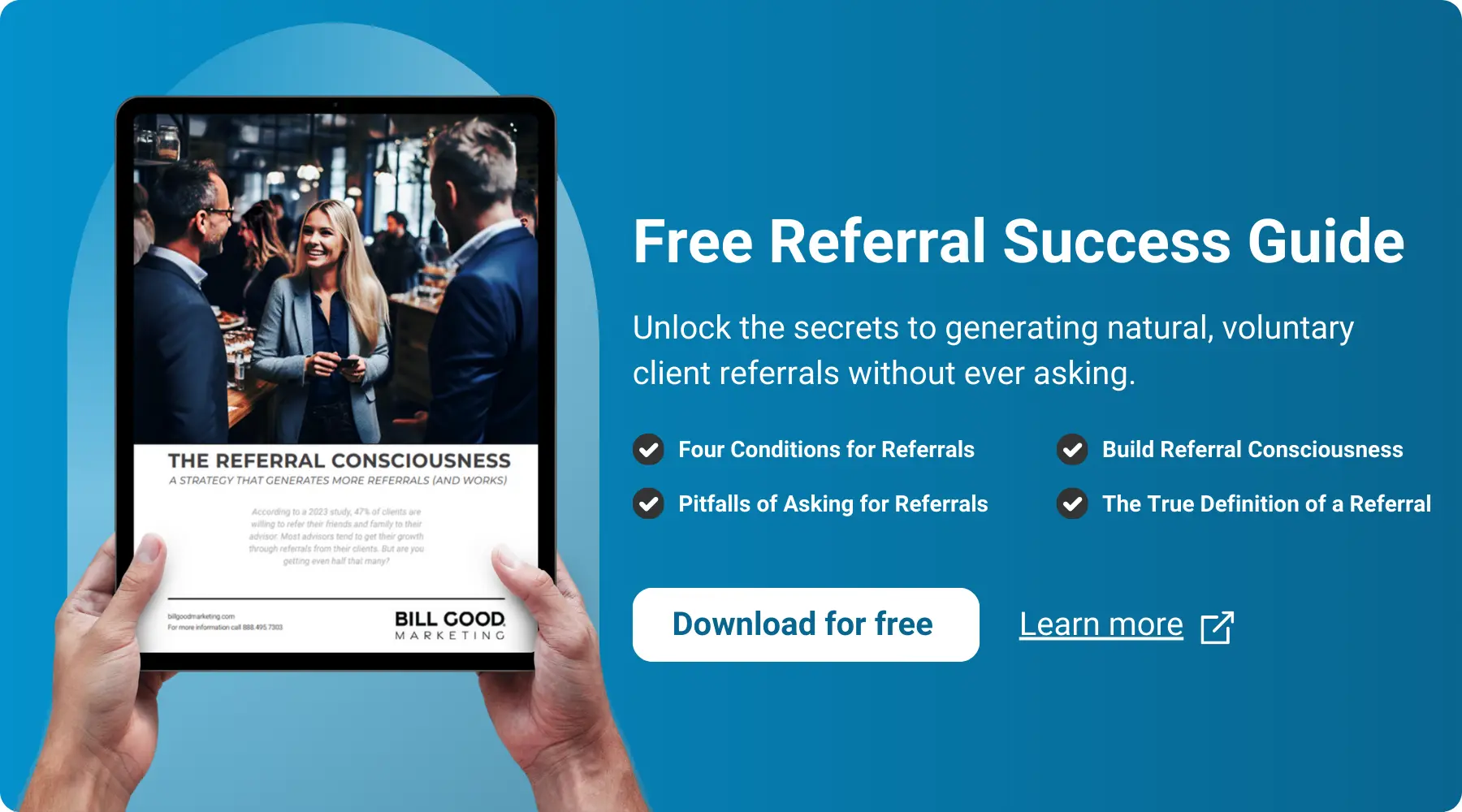There’s a story as old as this industry itself: How do you care for the clients you already have while still building the business you dream of?
Most financial advisors have faced this fork in the road—do you invest time nurturing your existing relationships or focus on acquiring new clients?
For decades, it’s been one or the other.
And both roads are riddled with challenges. Spend all your time with your client base, and your business growth stalls. Spend all your time with prospective clients, and your current clients feel neglected. But what if you didn’t have to choose?
That’s where the client service model comes in. (And, not to toot our own horn too loudly, but Bill Good Marketing had a little something to do with bringing this to life— more on this later!)
What Is a Client Service Model for Financial Advisors?
Before you get lost in the buzzwords of client engagement and workflows, let’s break it down.
A client service model is a framework that allows you to tailor your service to different client segments based on their unique needs, profitability, and potential.
It’s about building a system where financial planning services becomes more efficient, profitable, and scalable. Instead of treating all clients the same, you’re defining touchpoints, creating customized experiences, and meeting clients where they are—whether that’s in a review meeting or through a quick educational email.
Benefits of Implementing a Client Service Model
A client service model isn’t just a framework—it’s the way you ensure that you’re spending the right time with the right clients. It’s the key to unlocking growth without losing sight of what matters most: your relationships. Here’s why it’s essential:
1. Prioritize the Clients That Help You Grow
Not all clients are created equal, and a service model ensures you’re focusing your energy on the ones who fuel your business’s growth. Your top-tier clients deserve more than just a quarterly touchpoint—they need your personal attention and strategic thinking. When you spend your time on the clients who truly matter, you’re building a stronger foundation for future referrals and long-term partnerships.
2. Build Stronger, Lasting Relationships
Relationships are at the heart of financial advising, but not every relationship needs the same level of attention. A client service model allows you to tailor your approach—making sure every client feels valued, but your most important clients feel indispensable. This is how you cultivate trust, loyalty, and advocacy.
3. Scale Without Sacrificing Personalization
The right model allows you to grow your business without losing the personal touch that sets you apart. You can automate lower-tier client interactions while giving your ideal clients the attention they expect. It’s not about doing less; it’s about doing more of what matters.
4. Turn Referrals into a Growth Engine
Clients who feel supported and understood are the ones who refer you to others. A client service model that’s built to create meaningful, personalized experiences ensures that your ideal clients don’t just stay—they become advocates, bringing in new business for you without even asking.
Now that you understand why a client service model is so powerful, it’s time to dive into where this all began. The concept of service models and client segmentation didn’t just appear out of thin air—it was born from the vision of someone who saw the need for advisors to work smarter, not harder.

The Origin of Client Segmentation: How Our Founder Revolutionized the Wealth Management Industry
In the 1980s, our founder, Bill Good, recognized that financial advisors were juggling two tasks: managing clients and growing the business. The problem was that most were dropping balls.
Advisors spent too much time on clients who weren’t profitable, and too little on those who could drive the business forward.
So, in 1986, Bill introduced a new way of thinking with the release of Gorilla 1.0—the first CRM software that brought segmentation to life. Back then, it was all about classifying clients by “goodness.”
In practical terms, that meant grouping clients by AUM, responsiveness, and, yes, profitability.
The service models that came next were built on a simple but revolutionary idea: Spend time where it matters most.
The top clients? They deserved your full attention. Lower-tier clients? They’d still get a great experience, but it wouldn’t take all your time.
Fast forward to today, and this system has evolved into a sophisticated approach for wealth management and RIA firms across the country, allowing them to segment clients by more than just their wealth. It’s about client needs, financial goals, and how you, the advisor, can be a trusted partner on their journey. It’s a system exclusive to advisors who subscribe to our services.
Why Client Segmentation Matters More Than Ever
Financial advisors today have a new set of tools—apps, CRM systems, and automation—but the core challenge remains: How do you maximize your time and your client relationships?
The answer is still segmentation.
But instead of simply looking at net worth or revenue, you have to dig deeper.
The Bill Good System revolutionized the game by adding more dimensions to the equation.
The best advisors don’t just react to client needs—they anticipate them. And that’s where segmentation becomes a superpower. By understanding each client’s journey, you can map out how your service offerings align with their financial goals, ensuring that every interaction feels relevant and valuable.

Naming Your Client Service Tiers: The Power of Perception
In an industry like ours, where trust and perception are everything, the words we use matter. A lot.
When Bill first introduced client segmentation back in the 80s, most advisors followed a straightforward (and uninspired) approach to naming their client tiers: A, B, C. It was functional, sure, but it missed the mark on a crucial element of human psychology—no one wants to be ranked as second or third best.
That’s why we introduced a better way. We began using the names of precious stones—Diamond, Emerald, Ruby, Sapphire—to classify clients. Why?
Because no one feels “less than” when they’re associated with something of value. Diamond may be the top, but Emerald and Ruby still sound prestigious, still feel special, and still communicate to clients that they’re cared for and valued.
Here’s the brilliance of this shift: when a client hears they’re in the Sapphire group, they’re more likely to feel included, not excluded. The services they receive may differ from your Diamond clients, but the emotional experience is different from hearing “you’re in Tier C.” It’s the difference between feeling like part of a select club versus feeling like you’re sitting on the sidelines.
The key takeaway? The names you assign to your client service tiers should enhance the client experience, not diminish it. Clients need to feel like they’re receiving exactly what’s right for them, without the sting of comparison.
Perception shapes reality. And in the world of wealth management, perception can be the difference between loyalty and attrition.

Evolving Your Client Service Model Over Time
If there’s one thing that’s true in life, it’s this: nothing stays the same. Not your business. Not your clients. And certainly not their financial needs.
That’s why your client service model should never be set in stone. What works today may not work tomorrow, and the clients who need your attention most today may not be the same ones who do next year.
Every year, we recommend holding an annual business planning meeting. Think of it like a strategic tune-up for your business. During this meeting, take the time to re-evaluate each client in your book.
Have their circumstances changed? Have their financial goals evolved? Do they now have a higher potential for future revenue, or perhaps they’ve referred more clients to you? Maybe their client journey has taken a turn toward needing more intensive financial planning—or maybe less.
Here’s how you can approach it:
1. Re-Score and Review
Take your original client segmentation results and see if they still hold up. Have your clients’ lives changed? Did they sell a business? Experience a family change that affects their net worth or estate planning needs? Did they suddenly become more involved in their community, raising their potential as a COI?
2. Adapt Your Service Model
With these new insights, decide whether certain clients should be moved to a higher or lower tier. Promoting a client to a more exclusive tier is easy. Downgrading? A bit trickier. But here’s the thing: not all clients want to receive all the services offered to the top-tier. Some clients may prefer less frequent client meetings or may not need as many touchpoints. It’s about customizing the client experience to their needs, not yours.
If a client is used to a certain level of attention, taking it away can be a sensitive issue. Downgrading service shouldn’t feel like a penalty. The key is to explain why it makes sense for them. Maybe they don’t need monthly strategy calls—they just want an annual review and a few touchpoints to know they’re on track. Frame the conversation around their unique needs, and you’ll find that clients are more comfortable with changes than you might expect.
3. Leverage Technology for Consistency
With today’s technology, you can automate much of the legwork. Set up your CRM to trigger the right touchpoints at the right time. Whether it’s an app notification, a scheduled email, or an automated update on their financial planning progress, automation keeps you consistent—and consistency keeps your clients happy.
The end result? A business that grows with your clients without overextending yourself or your resources.
The Power of an Evolving Service Model
Bill has always said, “You’re either moving forward, or you’re moving backward. There’s no standing still.”
By continually adapting your client service model, you’re not just reacting to change—you’re anticipating it. You’re staying ahead of client needs, delivering financial advice that feels custom-built for their lives at any given moment, and offering services that fit their evolving client needs.
When done right, a service model becomes a living, breathing extension of your firm’s brand. It shows clients that you’re not just managing their money—you’re managing their well-being, understanding their demographics, and meeting them where they are on their client journey. This not only improves retention but also positions you as the differentiator in their financial life.
When you take the time to re-segment, adapt, and enhance the client experience year after year, you’re not just building a business. You’re creating something more valuable: long-term relationships, fueled by trust, designed to grow alongside the clients who matter most.

Pioneering Client Service Models and Financial Advisor Growth for Over 40 Years
Creating a client service model is not just about retaining clients; it’s about building lasting relationships that evolve with your clients’ needs. Whether it’s through regular client meetings, a webinar series, or leveraging social media to enhance the client experience, the model you build today will serve as the foundation for years to come.
At the heart of every great financial planner is the desire to help clients achieve their financial goals. With a well-crafted client service model, you can do just that—while growing your business and spending more time with your best clients.
For over 40 years, Bill Good Marketing has been at the forefront of helping financial advisors across the country not only build their book of business but also refine every aspect of their practice management. We pioneered the modern client service model and have helped financial advisors create scalable, profitable systems that support both client satisfaction and business growth.
From improving the onboarding process to developing strategies for hosting successful seminars, we’ve guided thousands of advisors through the intricacies of client relationships and the ever-evolving demands of wealth management.
Our goal has always been the same: to help you double production or work half as much.
If you want to learn more about what Bill Good Marketing can do for your client service models, your business growth, and your overall practice management strategy, feel free to contact us today. We’ve spent decades helping advisors just like you innovate, automate, and excel—and we’d love to help you do the same.
About the Author

Andrew D. White is the Director of Marketing at Bill Good Marketing, a firm with over 45 years of experience helping financial advisors scale their businesses. With deep expertise in advisor marketing, client acquisition, and retention strategies, Andrew specializes in creating high-impact campaigns that drive measurable results. His insights are grounded in real-world experience, working alongside top-performing advisors to refine prospecting, branding, and practice management strategies.




